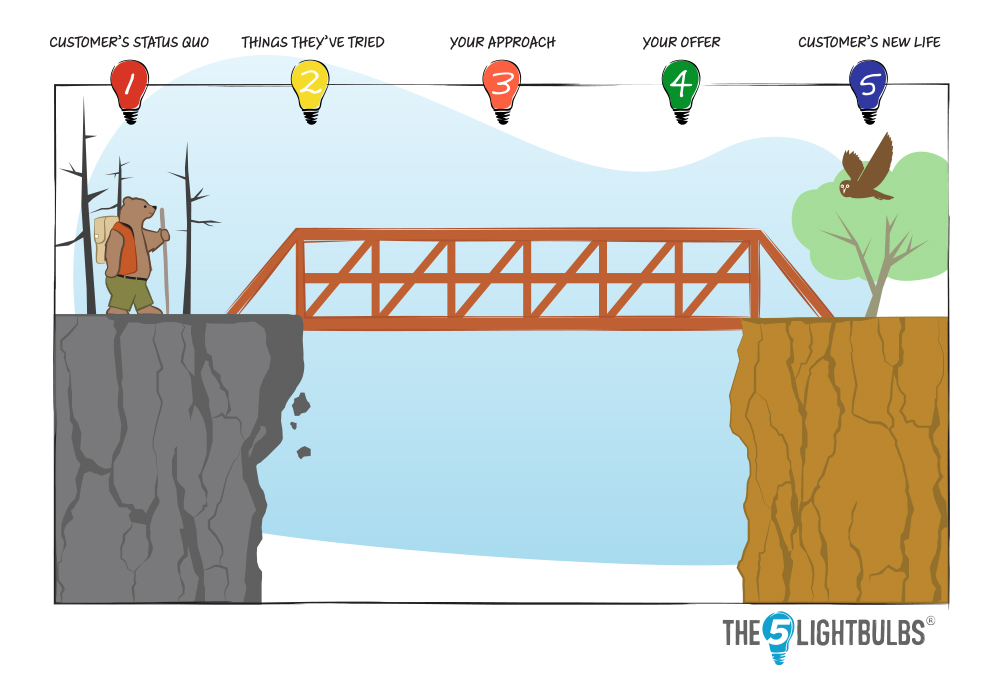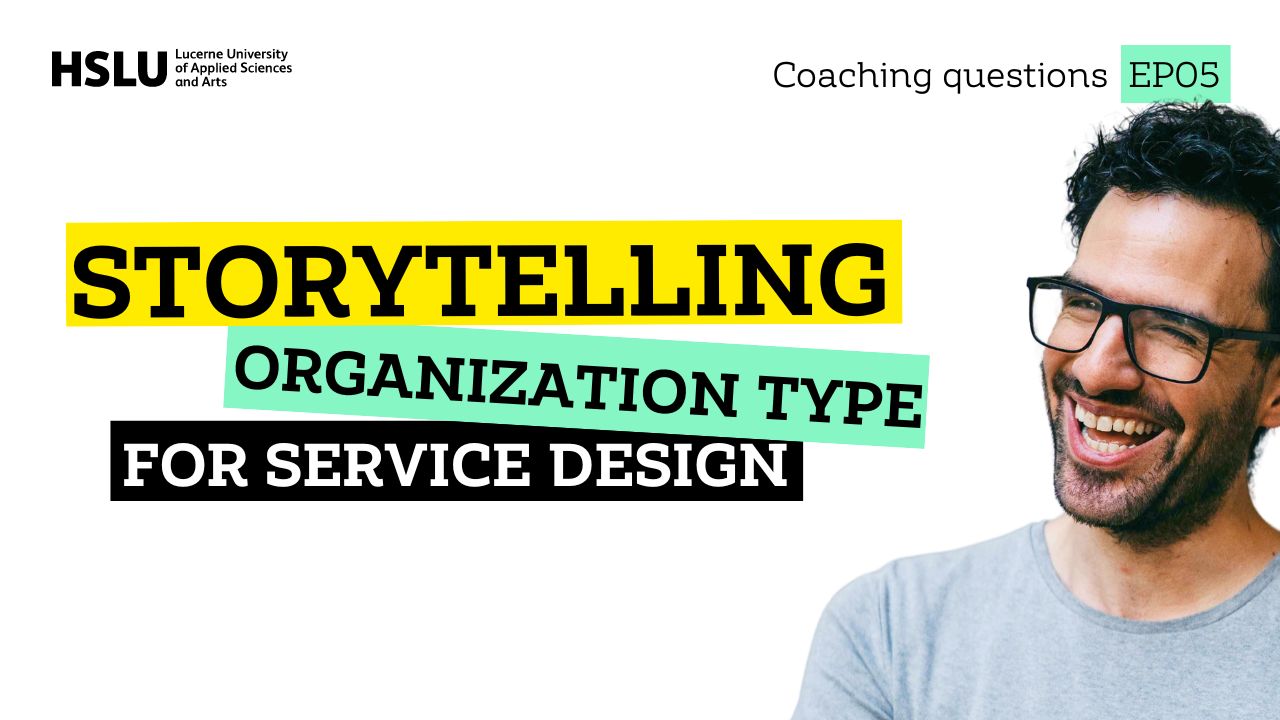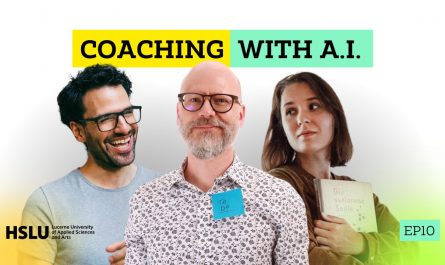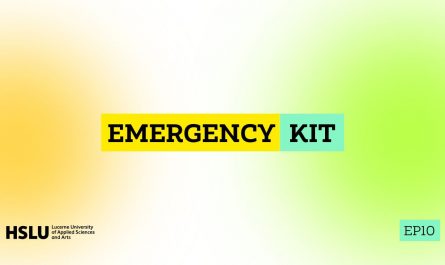Presenting new Service Design work is often a huge challenge because services are often intangible and a complex mess of dozens of touchpoints.
Coaching sessions with Sofiia Kaminska, Camila Meade and Maia Sevilla, students of the Master Service Design at the HSLU, inspired two tips that can help with the challenge of presenting new Service Design work:
- Think about the organizational structure: is your service a business, startup, association, movement, something embeded in another service or business?
- Use a storytelling framework: use a framework to help you summarize and stitch together the different aspects of your service in a coherent story seen through the eyes of the people you serve.
Tip 1: Think about the Organizational Structure
When sharing a new service design project, clarifing the organizational form can be super helpful. When you define whether the project will be a new business, an embedded service within existing companies, an association, or even a movement, it helps you reveal the blindspots of your project.
For example, framing a service as a movement puts emphasis on community engagement, volunteer recrutement and how to equip volunteers.
Tip 2: Use a storytelling structure
The Meet John storytelling structure
Service Design work is hard to present, but a good story can help to simplify complex services. But how do you get started? The structured storytelling framework called “Meet John” inspired by successful startup explainer videos can be good basis.

This framework consists of seven key steps that highlight the benefits of the service through the eyes of someone using the service.
The seven parts of the Meet John storytelling structure:
- “Meet John…” Describe who is the person that the service or product is serving.
- “Sadly, John has a problem…” Describe what the problem of John is and the emotions generated by that problem.
- “John finds service/product X by…” Describe how John joins the product or service and share the name of the service.
- “Now John can…” Describe how John benefits from the first key feature of the product or service.
- “John is empowered to…” Describe how John benefits from the second key feature of the product or service.
- “And finally he is able to…” Describe how John benefits from the third key feature of the product or service.
- “Because of X John feels now… and can…” Describe what John can do now that the problem is fixed and how he feels about it.
How this frameworks fits with Service Design work
The Meet John storytelling structure fits well with the service design work. It covers aspects like:
- user research by showcasing the users, their needs and pain points
- the service blueprint by showcasing key touchpoints
- the impact of the service by showcasing how the user feels after using the service
The Five Lightbulbs storytelling structure
There are many other storytelling frameworks out there. Another one I often use and recommend is The Five Lightbulbs framework by Billy Broas.

This framework is made of 5 stages:
- Your Customer’s Status Quo: what’s the unacceptable problem or painful situation that the person you want to serve is in?
- Other Things They’ve Tried: what are other things that the person has already tried to solve this issue but didn’t work?
- Your Approach: what’s different in the way you are approaching the problem?
- Your Offer: what are the features of the service you propose?
- Your Customer’s New Life: how do people feel when they use the service, how does their new life look like?
Automated transcript of the video
See the transcript
This transcript was fully generated using Descript. The transcript wasn’t corrected. Which means it can be pretty creative, funny or wrong at moments.
What are two tips to present new service design projects? The first one:
Reveal the organizational form.
And the second one:
Use a story to reveal the key parts.
Hi there. I’m Daniele one of the co-leads for the master service design program of the HSLU in Switzerland.
Today, I want to share with you two tips that were inspired by Maia Sevilla. Sofiia Kaminska, and Camila Meade.
And a big, sorry for butchering your last names.
Think about the organizational structure of your service
When speaking with Sophia about her project, which is a mix of digital ideation, product design and service design. One question came to mind.
What’s the organizational form of all of this?
Is this new service and project a new business?
Is it something that will be embedded in existing businesses?
Is it an association? Or is it something more like a movement?
As Sophia is working on a project around digital addiction. It makes sense for her to have something which is more like a movement.
If you frame a new service, more like a movement. It means that money isn’t the biggest challenge or the biggest topic that you want to address.
Because hopefully you will be able to get volunteers to help.
But if it is a movement, then comes the question. How do you equip and empower and motivate all of these volunteers to make that movement alive? And then also the question comes, how do you create a community of volunteers?
So knowing what’s the organizational form of this new service can really help to not only create clarity, but also see what are the missing parts in your service that you need to address?
This is especially true for students service design project, where you create a completely new service, that isn’t an improvement of something that is already existing.
And again, this question, doesn’t just create clarity on the money side, but also it reveals the parts that were maybe in the blind spot where now we discover, oh, I have to equip volunteers. So how do I create a toolkit for these volunteers?
And if it’s rather a business, then how do I make money?
And if your service is something that will be embedded within existing companies or existing services. Then the question is how do I motivate these companies or services? Two. Bring in this new idea within their existing thing.
Let’s move on to the second tip.
Why we need storytelling
This one is inspired by Maia and Camila.
Usually Service Design projects are a bit tough to present.
First of all service design is often intangible. Or when it’s tangible, it’s made of a dozens of tiny touch points that work all together.
Usually the way we present that is within a service blueprint, which is one of these very complex mappings that people outside of the design world. When they look at it. They just feel overwhelmed by it.
To fix that. Everyone says the same.
Tell a good story. But the question is, how do you do that? How do you get started?
The meet John storytelling structure
In my conversations with Maia and Camila, I suggested to:
Steal the playbook of the startups.
Many startups have these explainer videos that tell you within three minutes, what that startup does.
After seeing for years the kind of same structure used in these videos. I tried to summarize it into a template that I call the meet John storytelling framework.
It’s a seven step storytelling structure. That you can use as a basis.
We start by saying, meet John. And then we reveal a person that will benefit from the service.
Then we say, sadly, John has a problem. And then we explain the problem that this person has.
We then continue by saying John finds the service by doing something here.
We reveal how John gets to be aware of that new service and how he transitions to join the service.
Which is one step that many service designers forget to plan because they are so much focused on making a great service that they forget the marketing side of it. That we need to make people aware that this service. Exists.
Then we continue the story by saying: now, John can. Do something where we highlight one of the key features of the service.
And we do that three times by, for example, saying John is empowered to do something.
and finally we conclude by saying, because of this new service, John feels now and emotion. And the can. Do something better in his life?
Example of the Meet John Storytelling structure
Let me show how we can use exactly that structure for an accounting service like QuickBooks.
John is a carpenter who has a passion for creating beautiful. Chairs.
But he has a problem. It’s all of the shitty paper work that he has to do every tax season.
He hates it so much because it’s all the opposite of the creative word that he’s used to do. And that he’s good at.
One day, John has a coffee with his friend and painter Marisa. And he complains about all the paperwork. Marisa tells him,
I don’t have to do all of that. I just use my phone. And QuickBooks.
So curious, John installs the QuickBook app on his phone.
Throughout the year every time he spent some money, he just takes a picture off the receipt with his smartphone. And then automatically the app gets the amount and the category of expense.
At the end of the year, John can just click on a button to get a summary for his taxes.
And if John doesn’t feel so sure about sending that directly to the tax office, he still directly from the app can get a call with an accountant to finalize his tax documents.
Because of QuickBooks. John now feels much more creative because john spends nearly no time on admin work and can use all of that time to be even more creative with his design work.
That’s a quick example of how we can use that structure. To create a little story around an accounting service.
What to do with that structure
By using that structure, you can very easily create a storyboard or even a video of the new service proposition that you have.
How this storytelling structure fits with Service Design work
And what smart is that in that structure, it covers a lot of what we do in service design. It covers the research part, where we get to meet the people that we want to serve and discover their problems and emotions.
It covers the service blueprint by showcasing specific features and touch points. And it covers the impact that we will have on the lives of the people we serve.
Other storytelling frameworks
When it comes to storytelling frameworks, they are obviously way more than just this one.
Another one that has been very helpful to me is the five light bulbs framework.
There are many other ones and a simple Google search, will, reveal a lot of them.
Why start with a storytelling framework?
What is interesting to me was the storytelling frameworks. Is that they help me avoid the blank sheet syndrome where I’m blocked. I don’t know how to tell a story. With the framework. I just have to answer the questions or follow the recipe.
And usually like with any good recipe. I don’t just take the recipe. I add some spices, some elements that make it work better for my own context.
Closing words
So next time you present service design work, use these two tips:
Think about organizational structure.
And use a storytelling framework to explain your service through the eyes of the people that are using it.
Thank you so much to Sofiia, Maia and Camila for these inspiring coaching sessions.



